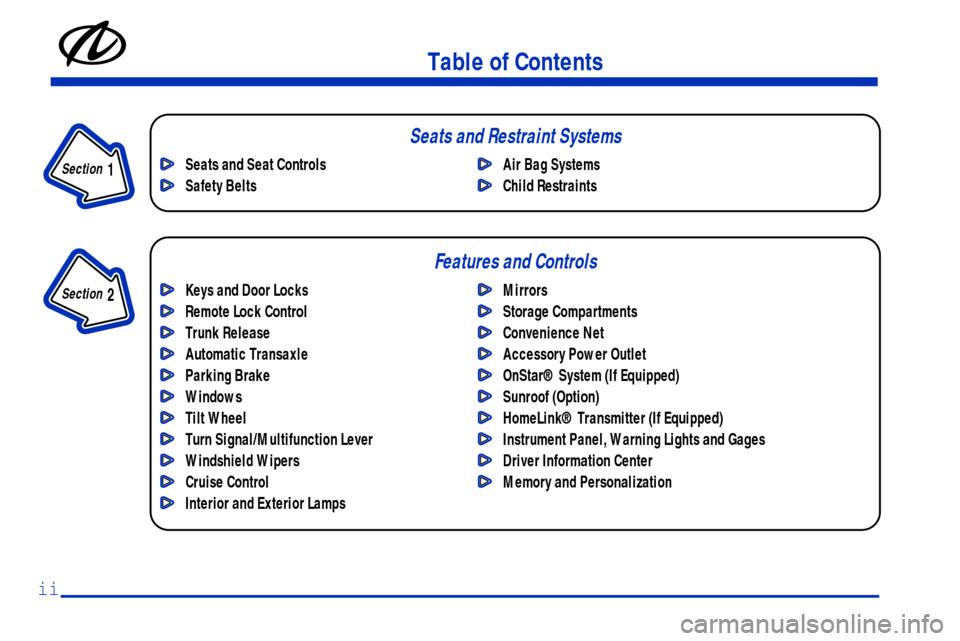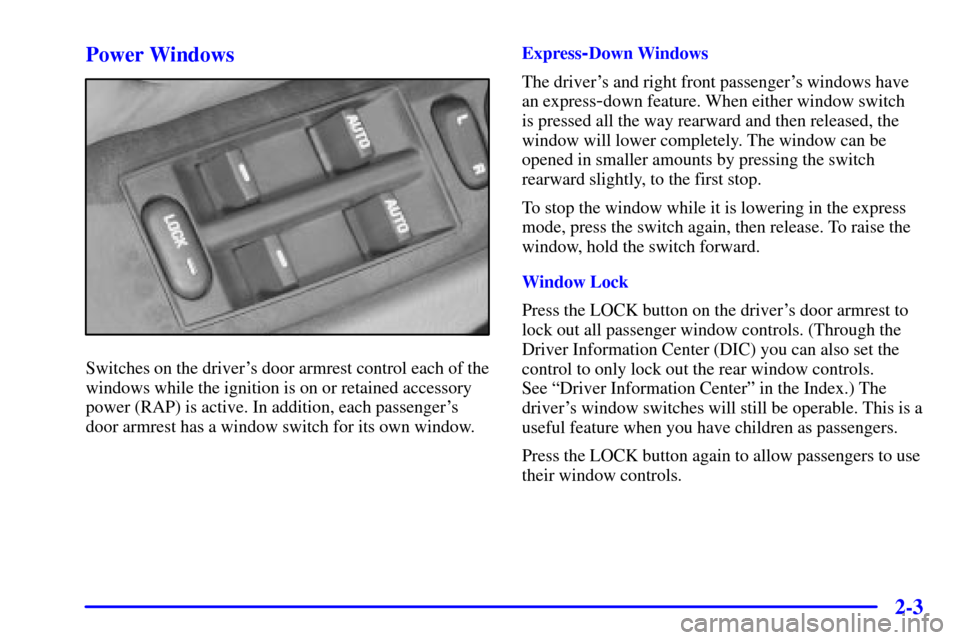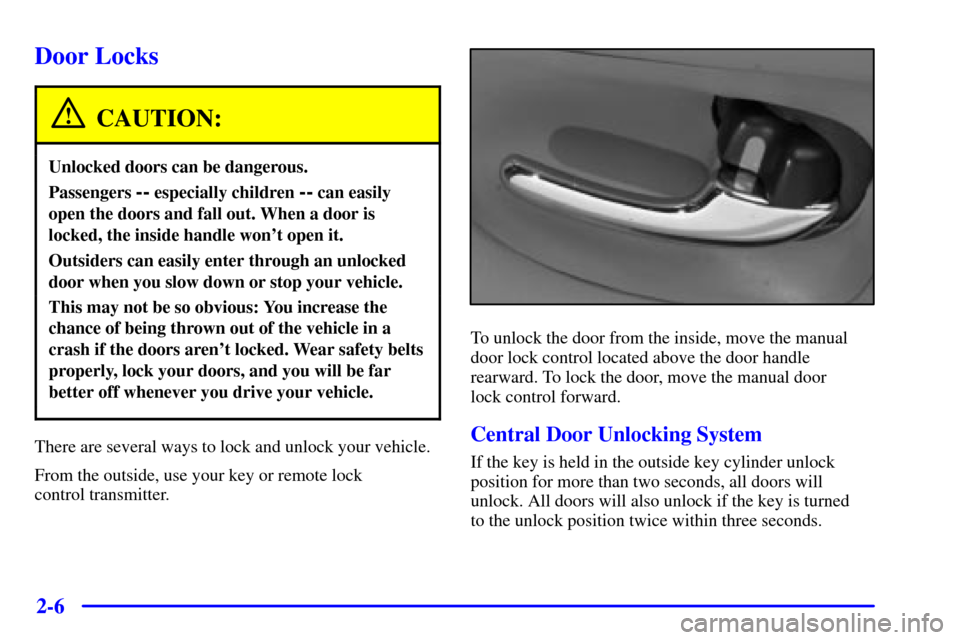child lock Oldsmobile Aurora 2001 Owner's Manuals
[x] Cancel search | Manufacturer: OLDSMOBILE, Model Year: 2001, Model line: Aurora, Model: Oldsmobile Aurora 2001Pages: 376, PDF Size: 2.67 MB
Page 4 of 376

Table of Contents
Keys and Door Locks
Remote Lock Control
Trunk Release
Automatic Transaxle
Parking Brake
Windows
Tilt Wheel
Turn Signal/Multifunction Lever
Windshield Wipers
Cruise Control
Interior and Exterior LampsMirrors
Storage Compartments
Convenience Net
Accessory Power Outlet
OnStar® System (If Equipped)
Sunroof (Option)
HomeLink® Transmitter (If Equipped)
Instrument Panel, Warning Lights and Gages
Driver Information Center
Memory and Personalization Seats and Seat Controls
Safety BeltsAir Bag Systems
Child Restraints
Section
1
Section
2
Seats and Restraint Systems
Features and Controls
ii
Page 33 of 376

1-21
The best way to protect the fetus is to protect the
mother. When a safety belt is worn properly, it's more
likely that the fetus won't be hurt in a crash. For
pregnant women, as for anyone, the key to making
safety belts effective is wearing them properly.
Right Front Passenger Position
To learn how to wear the right front passenger's
safety belt properly, see ªDriver Positionº earlier in
this section.
The right front passenger's safety belt works the same
way as the driver's safety belt
-- except for one thing.
If you ever pull the lap portion of the belt out all the
way, you will engage the child restraint locking feature.
If this happens, just let the belt go back all the way and
start again.
Air Bag Systems
This part explains the frontal and side impact
air bag systems.
Your vehicle has four air bags
-- a frontal air bag
for the driver, another frontal air bag for the right front
passenger, a side impact air bag for the driver, and
another side impact air bag for the right front passenger.
Frontal air bags are designed to help reduce the risk of
injury from the force of an inflating frontal air bag. But
these air bags must inflate very quickly to do their job
and comply with federal regulations.
Page 73 of 376

2-3 Power Windows
Switches on the driver's door armrest control each of the
windows while the ignition is on or retained accessory
power (RAP) is active. In addition, each passenger's
door armrest has a window switch for its own window.Express
-Down Windows
The driver's and right front passenger's windows have
an express
-down feature. When either window switch
is pressed all the way rearward and then released, the
window will lower completely. The window can be
opened in smaller amounts by pressing the switch
rearward slightly, to the first stop.
To stop the window while it is lowering in the express
mode, press the switch again, then release. To raise the
window, hold the switch forward.
Window Lock
Press the LOCK button on the driver's door armrest to
lock out all passenger window controls. (Through the
Driver Information Center (DIC) you can also set the
control to only lock out the rear window controls.
See ªDriver Information Centerº in the Index.) The
driver's window switches will still be operable. This is a
useful feature when you have children as passengers.
Press the LOCK button again to allow passengers to use
their window controls.
Page 76 of 376

2-6
Door Locks
CAUTION:
Unlocked doors can be dangerous.
Passengers -- especially children -- can easily
open the doors and fall out. When a door is
locked, the inside handle won't open it.
Outsiders can easily enter through an unlocked
door when you slow down or stop your vehicle.
This may not be so obvious: You increase the
chance of being thrown out of the vehicle in a
crash if the doors aren't locked. Wear safety belts
properly, lock your doors, and you will be far
better off whenever you drive your vehicle.
There are several ways to lock and unlock your vehicle.
From the outside, use your key or remote lock
control transmitter.
To unlock the door from the inside, move the manual
door lock control located above the door handle
rearward. To lock the door, move the manual door
lock control forward.
Central Door Unlocking System
If the key is held in the outside key cylinder unlock
position for more than two seconds, all doors will
unlock. All doors will also unlock if the key is turned
to the unlock position twice within three seconds.
Page 79 of 376

2-9
If you don't cancel the security lock feature, adults or
older children who ride in the rear won't be able to open
the rear door from the inside. You should let adults and
older children know how these security locks work, and
how to cancel the locks.
To cancel the rear door lock do the following:
1. Unlock the door and open the door from the outside.
2. Move the lever all the way down.
3. Repeat Steps 1 and 2 for the other rear door.
The rear door locks will now work normally.
Anti-Lockout Feature
The power door locks will not work if the key is in the
ignition and any door is open. You can override this
feature by holding the driver's power door lock switch
for more than three seconds.
Leaving Your Vehicle
When you leave the vehicle, open your door and set the
locks from the inside, then get out and close the door.
Remote Lock Control
You can lock and unlock your doors or unlock your
trunk from about 3 feet (1 m) up to 30 feet (9 m) away
using the remote lock control transmitter supplied with
your vehicle.
Your remote lock control operates on a radio frequency
subject to Federal Communications Commission (FCC)
Rules and with Industry Canada.
This device complies with Part 15 of the FCC Rules.
Operation is subject to the following two conditions:
(1) this device may not cause harmful interference,
and (2) this device must accept any interference
received, including interference that may cause
undesired operation.
This device complies with RSS
-210 of Industry Canada.
Operation is subject to the following two conditions:
(1) this device may not cause interference, and (2) this
device must accept any interference received, including
interference that may cause undesired operation of
the device.
Page 201 of 376

4-12
If you need to reduce your speed as you approach a
curve, do it before you enter the curve, while your front
wheels are straight ahead.
Try to adjust your speed so you can ªdriveº through the
curve. Maintain a reasonable, steady speed. Wait to
accelerate until you are out of the curve, and then
accelerate gently into the straightaway.
Steering in Emergencies
There are times when steering can be more effective
than braking. For example, you come over a hill and
find a truck stopped in your lane, or a car suddenly
pulls out from nowhere, or a child darts out from
between parked cars and stops right in front of you.
You can avoid these problems by braking
-- if you
can stop in time. But sometimes you can't; there isn't
room. That's the time for evasive action
-- steering
around the problem.
Your vehicle can perform very well in emergencies
like these. First apply your brakes. See ªBraking in
Emergenciesº earlier in this section. It is better to
remove as much speed as you can from a possible
collision. Then steer around the problem, to the left
or right depending on the space available.
An emergency like this requires close attention and a
quick decision. If you are holding the steering wheel at
the recommended 9 and 3 o'clock positions, you can
turn it a full 180 degrees very quickly without removing
either hand. But you have to act fast, steer quickly,
and just as quickly straighten the wheel once you have
avoided the object.
The fact that such emergency situations are always
possible is a good reason to practice defensive driving
at all times and wear safety belts properly.